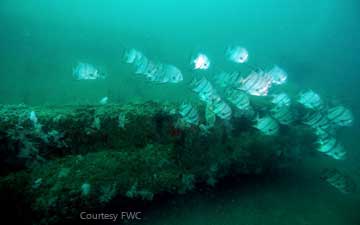Wreck Fishing

Wreck Fishing
Chances are you’ve heard at least one legendary tale of a ship lost at sea–even if that one story is about the Titanic. Many vessels have met their fate below the waves, due to storms, battles, tragic accidents, and yes, icebergs. While many shipwrecks have sadly brought those on board to the end of their lives, what remains at the bottom of the ocean has allowed new life to flourish. Scores of gamefish inhabit these wrecks, and anglers have learned to fish for them there.
What is Wreck Fishing?
Wreck fishing is all about making the most of vehicles that have made their way to the bottom of the sea. This includes ships, boats, planes, submarines, and much more. Wreck fishing usually involves pinpointing vehicles which sank by accident, but in some cases these vehicles are intentionally dropped there in order to form artificial reefs. The seafloor is riddled with wrecks, from the coast to the edge of the continental shelf. Even large rivers and lakes have wrecks of their own, most notably the Great Lakes.
No matter where you happen to find a wreck, it’s bound to be the source of outstanding fishing. This is because the vast ocean floor is much like a desert, with an empty, sandy bottom and few places for fish to hide. Once they find submerged structure, many species make themselves at home, and their predators prowl the surrounding waters. Many wrecks have resident fish populations as well as seasonal visitors, ranging from Snapper, Grouper, Amberjack, and Barracuda to Cobia, Tuna, and Sailfish. For anglers, it’s gamefish galore.
Anglers locate wrecks in a couple of ways: they either stumble upon them without knowing they’re there, or they follow Lawrence and GPS coordinates to find sites that other anglers have recorded. Many offshore wrecks were discovered by commercial fishermen whose nets got caught on sunken ships. In order to avoid running over the wreck a second time, they made a note of the coordinates, which then became common knowledge as anglers exchanged information. Today, you can buy charts with wreck coordinates in local tackle shops, sporting goods stores, and online.
Wreck Fishing Techniques
Wreck fishing is a lot like reef fishing, and you can use many of the same techniques. Anchoring up and chumming is an old stand-by, but drifting and trolling also prove effective in the right conditions. Fish might congregate in the wreck, near the wreck, or on one side of the wreck as influenced by the current–so knowing exactly where to anchor up is key.
While some fish can be coaxed to the surface, you’ll have to target others along the seafloor. Jigging and bottom fishing are two techniques which continue to be tried and true for Snapper, Grouper, and much more. In areas where it’s legal, spearfishing is yet another way to hunt for fish near wrecks.
In the Great Lakes, bottom fishing near a wreck can produce Walleye, Perch, Bass, and Catfish. Meanwhile, trolling in the same area will help you catch Salmon, Steelhead, and Lake Trout.
Wreck Fishing Gear
Wreck fishing gear includes a medium to heavy action rod with a conventional reel and 30-50 lb test line. Braided line is recommended, since it hardly stretches and is less likely to be cut by sharp edges. Bait, baited jigs, and heavy metal jigs all have their place in the angler’s arsenal.
In freshwater, you can rely on the same principles, but you usually need to scale down the tackle. Try using light-to-medium action spinning or conventional gear.
Where to Go Wreck Fishing
You’ll find wrecks in any ocean, whether you’re fishing a well-known hot spot or discovering a sunken vessel for the first time. These locations are just a few places where divers and anglers can have a field day exploring famous shipwrecks near The Florida Keys. From Key Largo to Marathon.
New England - The waters of New England have witnessed hundreds of shipwrecks, some of them dating back to the 1700s (and those are only the ones we know of!). The seafloor here is dotted with luxury cruise liners, pirate ships, and much more. Look for charters out of Maine, Vermont, New Hampshire, Massachusetts, Rhode Island, and Connecticut etc. for a chance to visit these sites.
The North East (UK) - The North East coast of the United Kingdom is littered with hundreds of shipwrecks, and these are among the most popular fishing grounds for local anglers. North Shields is one of the area’s leading port towns which offers recreational fishing trips to the offshore wrecks.
When fishing the wrecks, you never know what you’ll catch–and that’s exactly what makes this type of fishing so exhilarating! From plate-sized Snappers to massive Amberjack, anything you hook into will be a surprise.